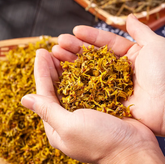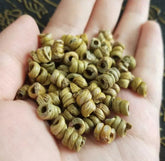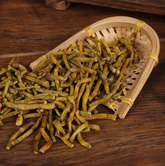Ganoderma - One of the Nine Noble Herbs
Ganoderma lucidum belongs to the family Ganodermataceae. It has a distinctive appearance. The fruiting body of Ganoderma lucidum is usually umbrella-shaped or kidney-shaped. Its cap can range from a few centimeters to over a foot in diameter, with a hard, woody texture. The surface of the cap is often shiny, smooth or with concentric ridges, and comes in various colors like red, brown, or black, depending on the variety and growth conditions.
It typically grows in temperate and subtropical regions, often on decaying logs, tree stumps, or dead tree trunks in forests. Ganoderma lucidum has a preference for hardwood trees such as oak, maple, and elm. It is a saprophytic fungus, meaning it obtains nutrients from decomposing organic matter. The growth environment needs to be relatively humid and with a certain amount of shade, which helps it thrive and develop its characteristic features.
In traditional Chinese medicine, Ganoderma lucidum has been treasured for centuries. It is considered to have a mild taste and a neutral nature. It acts on multiple meridians including the heart, liver, spleen, lung, and kidney.
It is believed to possess numerous health benefits. It can enhance the immune system, helping the body to resist diseases more effectively. It also has anti-inflammatory properties and is used to relieve inflammation-related symptoms. Additionally, it is said to improve sleep quality, relieve fatigue, and have antioxidant effects, which can slow down the aging process and protect cells from damage caused by free radicals.
Ganoderma lucidum can be used in various ways. It can be made into decoctions by boiling it with water along with other herbs. Dried slices of Ganoderma lucidum are also popular for making tea, allowing people to enjoy its potential health benefits through daily drinking. Moreover, it can be processed into capsules or extracts for more convenient consumption, especially in modern health products.
Ganoderma lucidum holds a special place in Asian cultures. In ancient Chinese culture, it was regarded as a symbol of longevity, good fortune, and immortality. It was often depicted in traditional paintings, literature, and folk tales, associated with gods and immortals. People believed that consuming or being in the presence of Ganoderma lucidum could bring health and a long life. Even today, it remains an important element in traditional cultural expressions and is highly respected for its perceived health-giving properties.
In modern scientific research, Ganoderma lucidum has attracted a lot of attention. Scientists have identified various bioactive compounds in it, such as polysaccharides, triterpenoids, and proteins. Studies have shown that these components may indeed have real pharmacological effects. For example, the polysaccharides have immunomodulatory functions, which can stimulate the activity of immune cells.
In conclusion, Ganoderma lucidum is not only a fascinating fungus with unique botanical features but also an important resource in both traditional medicine and modern health research, carrying with it rich cultural connotations and potential health benefits for people.
- Choosing a selection results in a full page refresh.







